Culture
Recounting Ethiopia’s Bitcoin Developments In 2024
Published
3 months agoon
By
admin
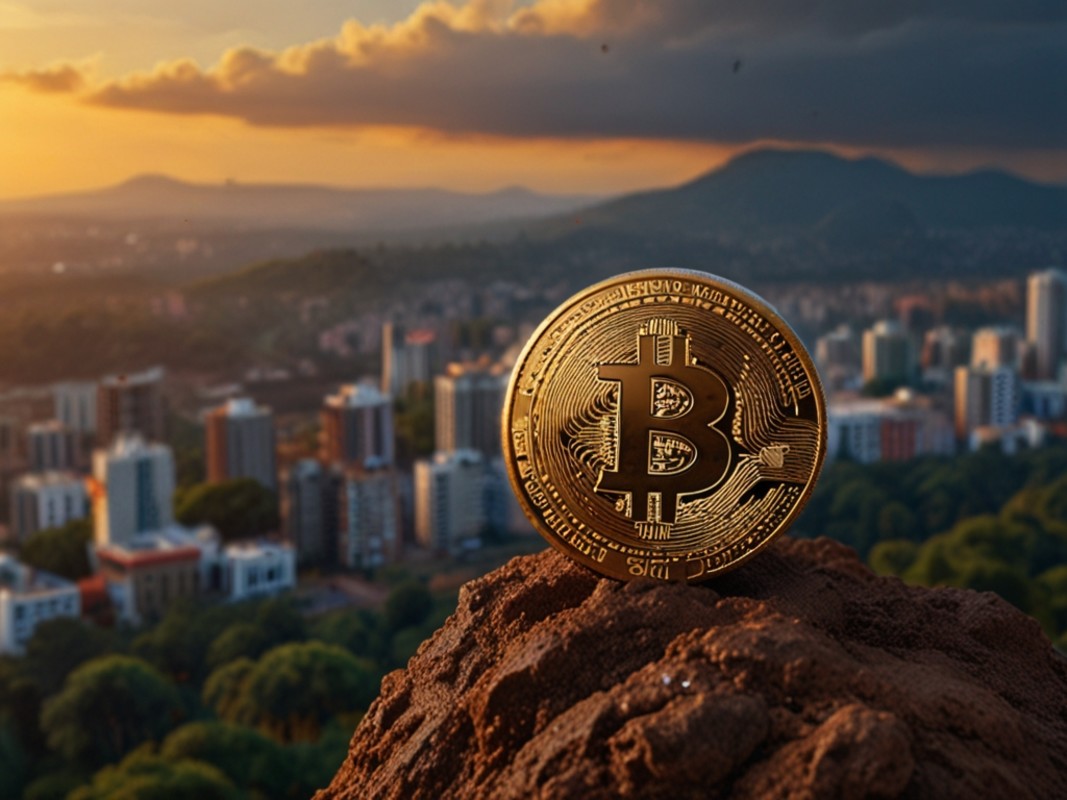
Ethiopia’s state-owned power producer, and a population of 126 million Ethiopians, welcomed the bitcoin mining industry in 2024 with an attractive electricity rate of USD 3.2 cents KWh. In this past year EEP has generated USD 55 million in revenues from bitcoin miners and expects USD 123 million in the year to come.
As we look forward to 2025, let’s take time to recognize the efforts and events in Ethiopia from the year 2024. These highlights can serve as a blueprint for how other energy-potential rich nations, even those too small or timid to challenge historical assertions about money, can also join in this race for energy and add-value to the bitcoin network.
First Quarter
- December 13, 2023, the Financial Accounting Standards Board (FASB) issued an Accounting Standards Update that addresses the accounting for and disclosure of “crypto” assets. Google Developers Group Addis (GDG Addis) invited Kal Kassa of BitcoinBirr and Dr. Nemo Semret of QRB Labs to speak at DevFest’23.
- RT published news of Russian investors setting up bitcoin mining facilities in Ethiopia. Shega features QRB Labs along with a Bloomberg Article on Chinese investors also working in bitcoin mining.
- February 12, 2024, BBC News Day Live interviewed Kal Kassa about bitcoin mining in Ethiopia. Then on February 21, 2024, Addis Standard published revenue figures of USD 2 million earned by Ethiopian Electric Power (EEP) from bitcoin miners. Within the year we will see this sales figure grow significant multiples.
- As the first signs of return in the bitcoin mining industry were reported, within days of each other, Bitcoin Magazine published 5 Ways Bitcoin Mining Benefits Ethiopia, then The Economist published Why Africa is Crypto’s Next Frontier and finally Addis Standard published From Shadows to Spotlight: Why Ethiopia Became Latest scene for Cryptocurrency Rush. In the first quarter of this year CNBC’s MacKenzie Sigalos also visited Addis Ababa to learn about this new industry.
Second Quarter
- Dr. Nemo Semret of QRB Labs published Bitcoin Mining in Ethiopia; the good, the bad and the ugly ahead of his interview with Hashrate Up Podcast and Gugut Podcast to talk about experiences building his facility and recent developments in the energy sector.
- May 3, 2024, Bloomberg’s Next Africa Podcast host Jennifer Zabasajja spoke with reporter Fasika Tadesse in a segment titled Ethiopia: An African Paradise For Crypto Miners?
- And on May 23, 2024, Addis Standard published revenue figures of USD 10.1 million earned by Ethiopian Electric Power (EEP) from bitcoin miners.
Third Quarter
- Blink publishes Bitcoin Mining in Africa: All Roads Lead to Ethiopia.
- August 25, 2024, Addis Standard published revenue figures of USD 27 million earned by Ethiopian Electric Power (EEP) from bitcoin miners.
- The Prime Minister of Ethiopia, Abiy Ahmed announces the Private Key Infrastructure (PKI) initiative in partnership with the Information Network Security Administration (INSA) to support local offices with cryptographic messaging and private-key related issues.
- BitCluster shared photos of its facilities in Ethiopia after deploying 12,000 bitcoin mining machines. In the third quarter of 2024 we also saw the eCrypto GitHub page publish an Amharic translation of the bitcoin whitepaper.
Fourth Quarter
- DINK TV and Genet Shiberu interview West Data Group in Bole Lemi for a tour of an operational 30 MW bitcoin mining facility.
- Ethan Vera of Luxor and Kal Kassa of BitcoinBirr joined The Mining Pod with Will Foxley to talk about Ethiopia’s Bitcoin Mining Boom.
- In the fourth quarter of 2024 we also learned that BitFuFu (NASDAQ: FUFU) was to acquire a 80-MW Bitcoin mining facility in Ethiopia. A few weeks later, Morningstar’s Newswire published BIT Mining Limited (NYSE: BTCM) completed the first phase of acquisition in Ethiopia for a deal that includes USD 2.265 million in cash and USD 12.015 million in shares.
- October 3rd, 2024, the Green Africa Mining Alliance (GAMA) hosted the Africa Bitcoin Mining Summit (ABMS ‘24) at Kuriftu Resort in Entoto Park, Addis Ababa.
- November 4, 2024, Fred Harter of The Africa Report published revenue figures of USD 55 million earned by Ethiopian Electric Power (EEP) from bitcoin miners. Forecasts for next year’s revenue from bitcoin miners stands at USD 123 million.
- November 5, 2024, The Bitcoin Summit ‘24 was hosted by BitcoinBirr at Sheraton Hotel in Addis Ababa. The event’s leading sponsor, West Data Group, announced news of a 20 MW facility in Wolaita Sodo breaking ground.
- Business correspondent Charles Gitonga of the BBC Africa interviews Kal Kassa on the Focus on Africa Podcast titled Why is Ethiopia a Major Hub for Bitcoin Mining? Addis Insight shared its article on the subject titled From Hydroelectric Power to Bitcoin: Ethiopia’s Rise as a Mining Hub.
- November 29, 2024, Ato Henok Assefa published How Bitcoin Mining Can Help Achieve Universal Electrification in Africa. That same week Henok Assefa joined the board of the state-owned Commercial Bank of Ethiopia (CBE). And days later we learned that Ethiopian Electric Power (EEP) will be under the new ownership of the Ethiopian Investment Holdings (EIH).
- Closing out the year, on December 5, 2024, the “Bitcoin” Telegram channel posts that 2.5% of the global Bitcoin hashrate now comes out of Ethiopia and that this number is poised to double in the next year.
Ethiopia’s next objective, if it’s to be supported by the various market actors and individuals involved, will be to contribute 1 GW of energy into the Bitcoin network.
The future of Bitcoin mining in Ethiopia depends on how the Ethiopian government will treat the industry. Since the industry is sensitive to energy, government offices should focus on electricity production, distribution, stability, immutability of commercial contract terms, clear customs procedures, and transparent tax laws. As I work with brilliant bitcoiners around the world, I am optimistic we will reach these goals. Stay humble, stack sats and have a beautiful new year!
This is a guest post by Kal Kassa. Opinions expressed are entirely their own and do not necessarily reflect those of BTC Inc or Bitcoin Magazine.
Source link
You may like


Kraken Secures Restricted Dealer Status in Canada Amid 'Turning Point' for Crypto in the Country


Binance Sidelines Pi Network Again In Vote To List Initiative, Here’s All
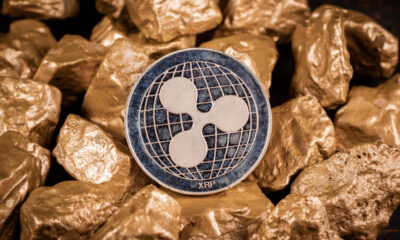

XRP Price Reversal Toward $3.5 In The Works With Short And Long-Term Targets Revealed


Former New York governor advised OKX over $505M federal probe: Report


First Digital USD (FDUSD) Depegs After Justin Sun Alleges Firm Is ‘Insolvent’ and Not Fulfilling Redemptions


Gen Z’s Bitcoin Bet, The Largest Wealth Transfer In History?

Michael Saylor, you were forced to realise that all the store-of-value assets are defective and pushed you to focus on the only asset that is not. That does not make you immune to seeing the medium of exchange case. You will see how the housing market is huge when you watch it from one point of view and horrible from another. But if you experience pain driving you to keep your billions of dollars purchasing power, housing is a decent tool to keep it.
Your SoV obsession misses the mark—badly. The biggest aspect of Bitcoin is the medium of exchange. Even though the fiat system increasingly separates money’s functions, that doesn’t mean it should. I get that saying Bitcoin is a medium of exchange is kicking the hornet’s nest, and all the other currency lords will try to stop Bitcoin. It’d be great if they joined in instead of fighting it. That will give all the billionaires certainty that they can put money in it, but simply using Bitcoin just to store value is attacking it. That approach will turn it into digital gold 2.0, captured.
There’s no store of value without a medium of exchange! The medium of exchange comes first. You receive a transaction, then you store the Bitcoin. If the store of value were the main point, imagine announcing you lost your keys for your Bitcoin stack—you’d still store it perfectly, but without the medium of exchange function, the market will wipe out the fictional fiat value layered on top. That value is there exactly because it can move and still can be used as a medium of exchange.
An oxygen tank is vital for reserves, but breathing matters more. The store of value is secondary and relies on the ability to transact. Without that, the store of value means nothing. Michael, you learned this firsthand when your million-dollar holdings in Argentina were diluted by 90%. You struggled to preserve the value not because you did not see it coming but because you couldn’t use it as a medium of exchange. True, a poor store of value weakens the medium of exchange, but why does the latter take priority? Because the ability to exchange is what lets you respond.

By now, most people exposed to Bitcoin know the chart from Jesse Mayers that you popularized. You claim there’s no better idea than a $900 trillion clean store of value, then immediately call Bitcoin one of the world’s most liquid markets, running 24/7/365. Guess what? Liquidity means medium of exchange.
Now, let’s break down the Jesse chart, starting with the housing market. It’s valued at $330 trillion, but it’s such a poor medium of exchange that it only trades for $1.3 trillion annually. Regulations and taxes make trading real estate even tougher. Still, since it’s more than 100 times better as a store of value, billionaires prize it, increasingly dominating the market and pricing out younger generations.
A house might be valuable, but its worth grows not just from what it is but from its ties to nearby utilities. Build a road to it, and the value rises. Add a superstore or a gas station, or connect it to the electrical grid, and the value climbs again. The network creates opportunities for energy to flow into the area, boosting the chance to capture that energy as economic value, like money. So the exchanges that happen in the network are what increases the value of a house. But I see the flip side: if you’re a billionaire and everyone’s after your resources, you don’t want a big network around your house. You’d prioritize privacy instead. The house might lose value, but the goal shifts to raising the cost for others to reach you, reducing the chance to be attacked.
What about the bond market? Bonds are valued at $300 trillion as a store of value, with $140 trillion traded yearly plus $25 trillion in new bond issuance. That means the medium of exchange value is about 50% of its total value annually. It’s better than houses in that sense, but the numbers still show people primarily use it as a store of value.
Next up are equities. Valued at $115 trillion, they were traded for about $175 trillion. This shows their strength as a medium of exchange exceeds their store of value role. Take your MicroStrategy stock—you know it better than anyone. How much value did it store last year, and how much was exchanged through it?
The next two sections are interesting. The art industry’s yearly transactions are so minor that they don’t even register on the chart. Meanwhile, the cars and collectibles sector sees trading volumes of nearly $4 trillion annually. This highlights that they’re mostly seen as a store of value each year, but it also reveals how poorly the housing market performs as a medium of exchange—outdone even by the car market.
Ooooh gold! Gold bugs rave that it’s been around for over 5,000 years, calling it the ultimate store of value for whatever reason—yet it’s just 1.78% of the store of value market. This shows that once its medium of exchange role was stripped away, it became vulnerable to capture and manipulation. Sorry, gold bugs, that genie’s not going back in the lamp. Gold holds $16 trillion in value, and the gold bugs claim it could store the $120 trillion worth of money in it. They’re desperate to pump their bags, but the market disagrees, valuing the defective fiat money ten times higher than the shiny, lifeless rock. Is gold a better medium of exchange, then? It trades at $54 trillion yearly, boosted by derivatives, making its medium of exchange use 3.5 times its store of value role.
Money might not dominate as a store of value among assets, but it’s the leading medium of exchange by far. Other stores of value assets don’t even come close. What if the dollar, the top currency, became just a store of value? It would collapse the USD network, boosting the value of non-US assets as their networks step in to meet the demand. Over time, their store of value assets would rise while USD assets would plummet. Global money totals around $120 trillion, but look at the top central banks’ transaction volumes: Fedwire at ~$1,182 trillion, TARGET2 at ~$765 trillion, CHAPS at ~$145 trillion, and others (partial) at ~$500 trillion (a conservative estimate due to incomplete data). So, while the store of value is $120 trillion—per the Jesse chart—the medium of exchange utility of these networks is over 20 times greater, which is around ~$2.5 quadrillion. What would the medium of exchange value be if 2 billion unbanked people were included? How many more transactions would that spark? And what if microtransactions were possible?
Where does Bitcoin fit into all of this? The prevailing narrative urges holders never to sell, positioning Bitcoin solely as a store of value. Yet, the market tells a different story. In 2024, Bitcoin’s market cap hit $2 trillion, while the value exchanged on its first layer—the blockchain—reached $3.4 trillion. Factor in the Lightning Network (though its exact figures remain elusive), and the total likely approaches $4 trillion. This suggests that Bitcoin’s role as a medium of exchange is twice as significant as its store-of-value function. So, what happens if that long-standing “hold forever” propaganda narrative begins to fade?
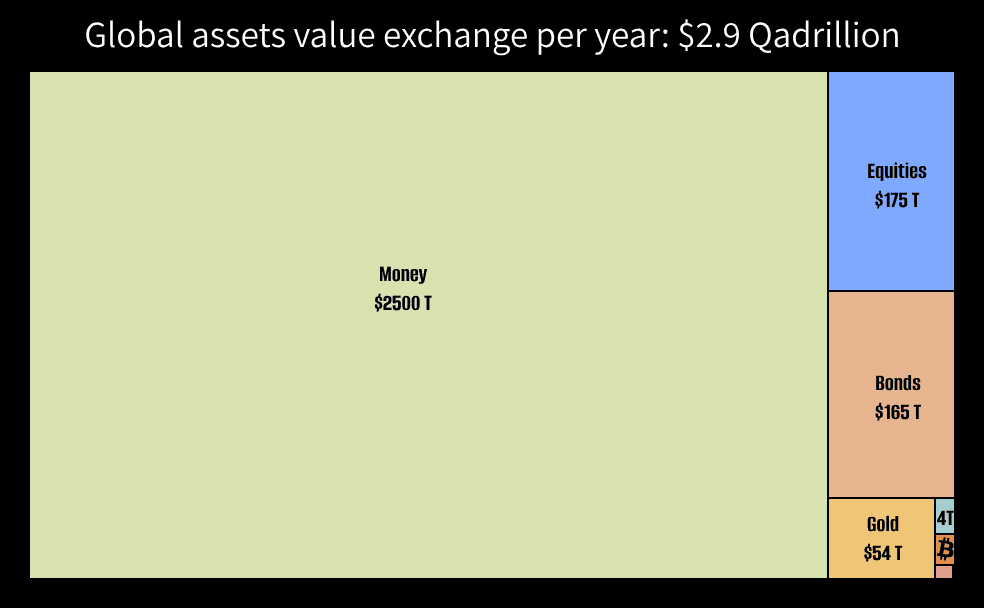
Bonds and equities are financial “instruments” that pretend to be money because fiat currency is flawed. This creates a market that shuts out much of the population from safeguarding their wealth, further splitting money’s store of value role. But how inclusive are these instruments? Or are they just tools to siphon value from the fiat medium of exchange, channeling it to privileged individuals and billionaires and others alike with a need to hoard?
Globally, only 10-20% of people have exposure to bonds, mostly indirectly through pension or investment funds, not directly. For equities, 15-25% of the population has some access. That leaves at best 80% of humanity without these tools to protect themselves, making them vulnerable to exploitation. Splitting the store of value from the medium of exchange sets up a dynamic of extractors and the extracted. This amplifies the “cantillion effect”: those who can print the medium of exchange buy up store-of-value assets, sidelining 80% or more of people. It’s a feedback loop that weakens the system, widening the gap between haves and have-nots. The more you print, the more you disconnect money from its store-of-value role.
Another very big part of the whole system is the fees. There are fees for sending dollars via the banking system, and that is a service, but how much are the fees when you want to switch from the medium of exchange into the store-of-value instruments? A lot more. That is creating so much friction in the whole system, and it contributes to excluding the have-nots from storing their value. At this point, the medium of exchange turns more and more into the medium of extraction rather than for exchange. This is also a reason why the store of value case is more appealing in the fiat system.
Bitcoin is not pretending to be money like everything else; it is the first engineered money that doesn’t erode like a melting ice cube and doesn’t discriminate. It is the money of those who choose it. With no printer behind it, there’s no urge to swap it for a “better” store of value—there’s no second best. Even those without Bitcoin can use it to shape their lives into the lives they desire. Moving away from chasing money to store in something and instead building whatever enriches their lives on top of Bitcoin.
The biggest idea isn’t storing value—it’s moving it. But to move value, you first need to have some stored. Then again, to have some stored, someone needs to move some your way first. That’s why the rich prefer assets that don’t erode like a melting ice cube. Meanwhile, those starting their careers focus more on receiving value than storing what they don’t yet have.
Why does the store of value case draw so much attention? One reason could be the effort involved. With a store of value, you buy and hodl—no work needed to improve your life. With a medium of exchange, you must work to grow your savings, persuading others to pay for your goods or services in Bitcoin. Another factor: for most, their fiat portfolio still outweighs their Bitcoin one. Only when Bitcoin surpasses their fiat holdings will they consider enhancing their lives with it. That shift isn’t tough for much of the world’s population, who lack savings or assets anyway. This might explain why the current system resists letting them exit, pushing dependency by offering to custody their Bitcoin—trading one reliance for another.
Even ossification ties into the need for more mediums of exchange use. You, Michael, strongly support ossification, but if Bitcoin isn’t used to reach more people, you’re delaying it. Unlike you, America knew that to make the dollar the world’s reserve currency, they had to distribute it widely to lock in the network effect. They saw the network as the key to ossification, and it worked easily since printing and sharing bills cost little. With Bitcoin, its absolute scarcity requires balancing how much to spread versus store. Still, that doesn’t mean you shouldn’t spend any at all.
The metaphor of storing fat in the body is key to long-term survival. True, but it overlooks the need for a steady food income to stay alive before storing fat. Without income, there’s nothing to store—so exchange comes first. Yet, for someone not worried about hunger, the focus shifts to storing food to prevent spoilage. I keep hammering this point to highlight your bias toward the store of value, which skews your judgment and misleads others.
At this stage of my Bitcoin journey, I’m certain of this: chasing money corrupts you. Bitcoin shifts that—it stops you from pursuing money endlessly and lets you use it for the life you want. What happens when you have enough of everything you desire? What then? With Bitcoin, that’s entirely possible, and every Bitcoiner should be ready with an answer for when it happens. Chasing money, though, is a bottomless pit you can’t fill. The Bible says the love of money is the root of all evil. I agree, but how does it play out? What is the mechanism? Chasing money—making it the top priority and making the other things lesser—is the mechanism.
You’re not building a Bitcoin standard—you’re stacking a deck. Like gold in the past, you’re the one this time hoarding Bitcoin from people and institutions, further entrenching the fiat standard. Saylor, you’re not attacking the dollar as some believe—you’re bolstering it by boosting your stock and its ecosystem. Instead, you’re speculatively hitting those who fund your Bitcoin buys. You’re not just hurting them; by strengthening the dollar, you’re amplifying the pain for other currency holders. Hoarding sats while the world watches? That’s not a cybercity—it’s a gated estate funded by their own money.
I wonder if people would want to invest their Bitcoin in your securities. How many would actually do it? I’m sure true Bitcoin maximalists wouldn’t trade their perfect store of value asset for a fiat “instrument.” Ask yourself: at this point, would you spend your Bitcoin to buy Apple stock? You did invest in them before, after all. It makes no sense—I’d give you Bitcoin just for you to turn it into some fiat thing, pay fiat fees, bolster fiat custodians and third parties, only so you can buy Bitcoin again on the other end.
In the end, I don’t have proof, but I’m fairly certain you already know everything I’m saying in this article/message. Though it’s written to you, Michael, it’s aimed at those who see you as the new Bitcoin Jesus, blindly following without questioning your actions. They make reckless bets in their own lives—bets that could wipe out their Bitcoin—lacking the financial safeguards and interest rates you have. Your messages, which they echo, don’t apply to most of humanity.
Bitcoin isn’t just another asset or financial tool—it’s borderless, permissionless money for the people. Treating it otherwise diminishes its true worth. Merely storing it won’t bring freedom. Letting sats flow builds the network. Letting sats flow fosters cooperation for a better future. Letting sats flow strengthens the ecosystem. Store some for tomorrow, but do not be the richest man in the grave—save them for plans that keep them moving later.
This is a guest post by Ivan Makedonski. Opinions expressed are entirely their own and do not necessarily reflect those of BTC Inc or Bitcoin Magazine.
Source link

As bitcoin moves into the mainstream of American life, people from every background and corner of the planet are contributing to its historic rise. In the spirit of the age, the bitcoin industry is largely a meritocracy. It is the quality of contributions—rather than any singular identity—that drives bitcoin forward.
March is recognized as International Women’s Month, a tradition rooted in early-20th century labor and suffrage movements. It provides an occasion to reflect on the role of women in bitcoin. Rather than focusing on the experience of being a woman in a technical field, this article spotlights the real contributions and leadership from individuals who happen to be women but who have each, in their own right, helped shape the bitcoin ecosystem.
Whether they come from legal, financial, or technical backgrounds, individuals with strong foundational skills often transition naturally into the bitcoin industry. Much of bitcoin’s growth can be credited to those able to distill complex technical concepts into accessible language. Women are excelling in this role, using skills in marketing, community organizing, and storytelling to broaden understanding and trust in bitcoin. It’s one thing to code or invest in bitcoin, but quite another to convey its principles effectively to the uninitiated. As more people demonstrate real skill in bridging that knowledge gap—through podcasts, workshops, or online content—bitcoin’s base of educated users expands exponentially.
“Women can be powerful communicators and community builders, finding ways to distill complex topics into easily understandable and relatable bites,” says Kelley Weaver, CEO of Melrose PR & Founder of Bitwire. “Since bitcoin fundamentally grows through network effects, this is essential! I’ve seen firsthand how women’s approaches to explaining bitcoin can reach people who might otherwise be intimidated. Approachability is essential for bitcoin’s long-term success.”
In recent years, bitcoin ownership among women has risen significantly. One survey showed that women’s share of digital asset ownership jumped from 29% to 34% in a single quarter. While these numbers vary depending on the source, there’s a clear upward trend. If finance was once perceived as a male-dominated space, that narrative is shifting—particularly for a technology-driven asset like bitcoin, which democratizes participation by removing traditional gatekeepers.
“Across ‘Main Street’ America and the world… decentralized networks of female leaders can be a catalyst for financial education and increasing understanding about the transformative nature of bitcoin,” says Cleve Mesidor, Executive Director of Blockchain Foundation. “Particularly because of scarcity, most individuals will never own even a fraction of bitcoin, which is why women cannot afford to be late adopters.”
Mesidor points to a key dynamic: informal, community-driven networks excel at spreading education. Because bitcoin can be learned and shared peer-to-peer, it finds fertile ground in the natural social structures that women have historically led, such as book clubs, parent associations, and charitable groups. Such networks become informal “nodes” of adoption, where knowledge flows more freely than it might in a top-down environment.
In the past, popular culture often portrayed men as the family financiers while women managed daily household tasks. Yet a recent study revealed that about 84% of women say they are responsible for their family’s finances, from paying bills to setting budgets to overseeing savings and debt obligations. Perhaps more remarkable is that almost all women in couples (94%) report being actively involved in shaping household financial decisions. Many women effectively act as Chief Financial Officers for their families, handling budgeting, strategic planning, and long-term goal setting.
As bitcoin continues to gain traction worldwide, it is increasingly one of the tools under consideration, especially for those who like to plan with a low-time-preference mindset. Bitcoin’s design fits neatly with the mindset that prudent financial planners rely upon. Its limited supply and disinflationary monetary policy reward disciplined saving. As families look for ways to preserve purchasing power, it is natural to add bitcoin in the mix. Whether it’s a small allocation every month or a larger diversification strategy, bitcoin attracts those seeking reliability over the long run.
“For long-term investments, bitcoin is a top choice. While short-term fluctuations are inevitable, its overall trajectory shows a clear path toward growth and stability.” says Frieda Bobay, co-founder of Bitcoin Sports Network. “I never plan to sell my bitcoin; instead, I view it like real estate—an asset I can borrow against while it continues to grow in value.”
While it’s easy to over-generalize, data does suggest that women, on average, tend to adopt disciplined approaches to money management. They trade less frequently in stock markets, are more likely to stick to a plan, and often do deeper research before making an investment. One of bitcoin’s most emblematic qualities is its alignment with low-time-preference thinking: favoring long-term wealth building over short-term speculation. Studies have shown that women are often methodical, patient, and focus on fundamentals rather than jumping in and out of markets. This mindset leads to outperformance in traditional investment contexts.
“A common misconception is that bitcoin is ‘too expensive’—in reality, this is a matter of unit bias,” says Hailey Lennon, General Counsel at Fold. “Many people don’t realize you can own fractions of a bitcoin, and by that measure, it’s still incredibly early and relatively cheap when you compare it to traditional assets. If women empower themselves with the basic knowledge of how bitcoin works, they’ll see that we’re just at the beginning of its potential, making it a compelling opportunity rather than an exclusive, high-priced investment.”
Lennon’s perspective highlights a key barrier for new entrants: bitcoin’s per-coin price might intimidate some, but the option to purchase fractions (satoshis) lowers that barrier significantly. That’s often an eye-opener for people new to bitcoin—especially those who excel in careful, long-term budget allocation. By embracing the possibility of stacking small amounts, methodically and regularly, one can build a meaningful position over time.
Weaver agrees: “Slow and steady wins the race! My personal strategy is to DCA, or “dollar cost average” meaning that I purchase small amounts daily. This spreads out risk. I ultimately think it’s more risky to NOT own bitcoin in the long term, but I also recognize that it’s incredibly volatile. I always say in the short term it may never be a good time to buy bitcoin but in the long term it’s ALWAYS a good idea to buy bitcoin.”
Another reason for the surge in interest among women is that bitcoin, as a universal asset, offers financial independence and sovereignty. This resonates strongly with individuals who value autonomy. “Bitcoin is the pathway to financial sovereignty. It removes traditional gatekeepers and allows for independent wealth management without intermediaries,” says Evie Phillips, Founder of Creeds Collective & Founding Board Member of Crypto Connect, now Eve Wealth. “The blockchain’s immutability means assets can’t be frozen or seized—this is specifically valuable in relational situations and regions where women face financial restrictions. Bitcoin doesn’t have geographic limitations, making global transactions seamless, and that opens up a flood of opportunities that aren’t available through centralized financial systems.” Phillips’s point highlights bitcoin’s advantages in personal control over assets. The economy is fundamentally transforming, and many are drawn to the reliability of an asset that exists beyond the reach of institutions.
The novelty of bitcoin can be intimidating, especially because the mainstream media frequently associates it with scams and hype-driven speculative bubbles. Thought leaders in bitcoin address this by pointing to the facts of the technology. “The more I learn about bitcoin, the more I trust this trustless financial system,” says Weaver. “The network has had zero downtime since it launched in 2009 and has never been hacked. Over the course of bitcoin’s history, the price has risen and fallen, but consistently trends upward in the long term.”
Bitcoin is a protocol, and using it does not require trust in any central authority. Yet it thrives on trust, education, and consensus among people. This is why communicators matter so much. “I often see women’s entire perspective shift when they recognize bitcoin’s potential—not just as an investment, but as a vehicle for financial empowerment,” says Megan Nilsson, host of the Crypto Megan Podcast. “By leveraging their ability to build networks, drive education, and advocate for broader adoption, women can play a leading role in shaping the future of bitcoin and decentralized finance… Bitcoin has fundamentally redefined the concept of financial independence. It has leveled the playing field, offering financial tools that were once only available to accredited investors. It eliminates reliance on centralized systems, providing individuals with true ownership and control over their wealth.”
In the coming years, the world economy, and society itself, will be reshaped by the convergence of transformative technologies including AI, robotics, and space travel, all underwritten and financed with bitcoin. It’s no wonder that as families, institutions, and communities discover bitcoin’s utility, so many of those leading the charge are women. They do so not because they want to check a box, but because the technology itself demands the best talent available. In celebrating the achievements of women this month, we also celebrate bitcoin’s potential to reshape our collective future. It is a global experiment buoyed by those who see beyond the hype and dedicate themselves to building, teaching, and expanding the Bitcoin Network for future generations.
This is a guest post by Dave Birnbaum. Opinions expressed are entirely their own and do not necessarily reflect those of BTC Inc or Bitcoin Magazine.
Source link
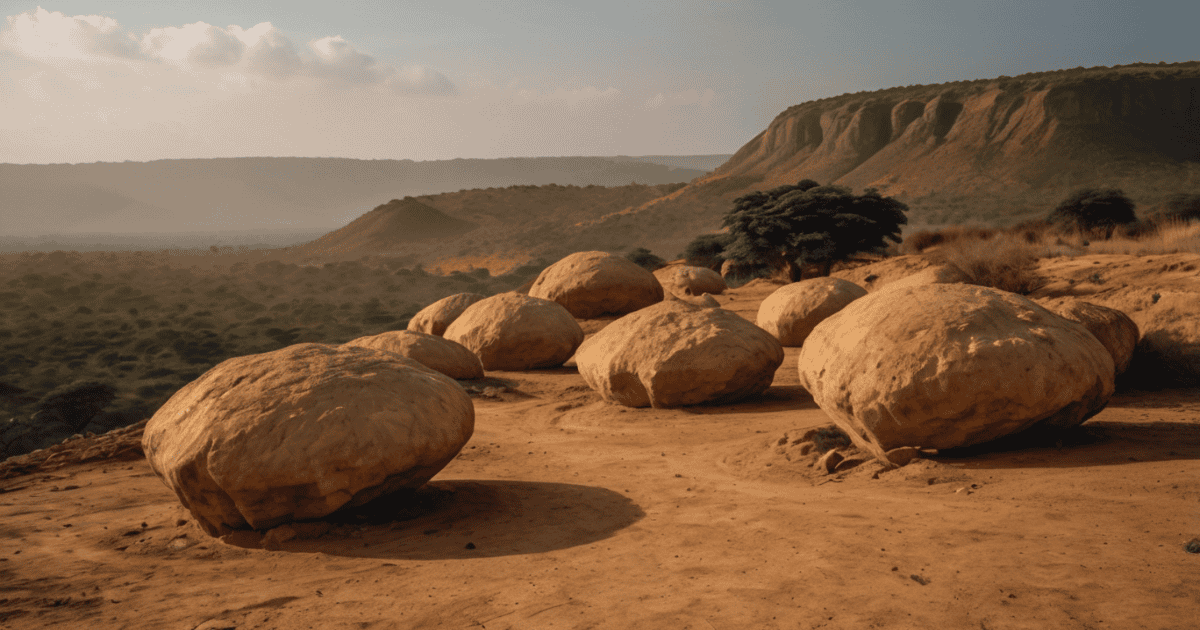
South Africa Reserve Bank(SARB) governor’s question, “Why not strategic beef reserve?” at the 2025 World Economic Forum in Davos may have been rhetorical, but Lesetja Kganyago’s seemingly sarcastic remark about “strategic bitcoin reserves” inadvertently underscored the need for Africa to rethink its economic strategies in the face of global financial shifts. In a world increasingly defined by digital transformation, the concept of money and value storage is evolving rapidly. Africa is no stranger to commodity-based economies. From oil to gold, beef to cocoa, the continent has long relied on natural resources for economic sustenance. However, these commodities are fraught with challenges. Global commodity prices are highly susceptible to market fluctuations, geopolitical tensions, and climate change. For instance, the price of beef can swing dramatically due to disease outbreaks or trade restrictions, just the way the value of fiat currencies swings and remains unpredictable when traded against digital assets like bitcoin due to regional financial policies and currency devaluation. According to the Food and Agriculture Organization (FAO), beef prices have experienced volatility of up to 30% year-over-year due to factors like foot-and-mouth disease and export bans.

Image Source : FAO
Even though Brian Armstrong, CEO of Coinbase, responded to Kganyago’s question with a compelling argument: Bitcoin is not just a better form of money than gold, it is also more portable, divisible, and utility-driven. Over the past decade, Bitcoin has outperformed every major asset class, cementing its position as a superior store of value. For Africa, a continent often marginalized in the global financial system, a Strategic Bitcoin Reserve could be the key to unlocking economic independence, fostering innovation, and securing long-term prosperity. How?
It’s time to be factual and realistic in our comparison. Bitcoin exists digitally and requires no physical storage, commodities like beef and mutton are perishable and costly to maintain. The World Bank estimates that post-harvest losses for agricultural products in Africa amount to $48 billion annually, highlighting the inefficiencies of commodity-based reserves. While commodities have intrinsic value, their utility is restricted to specific industries. Bitcoin, on the other hand, is a global, borderless asset with applications in finance, technology, and beyond while its unique properties make it an ideal candidate for a strategic reserve asset. With a capped supply of 21 million coins, Bitcoin is inherently deflationary, unlike fiat currencies that can be printed indefinitely or beef with endless reproductive mechanisms. According to CoinMarketCap, Bitcoin’s market capitalization has grown from less than 1 billion in 2013 to over 1 trillion in 2025, demonstrating its rapid adoption and value appreciation.
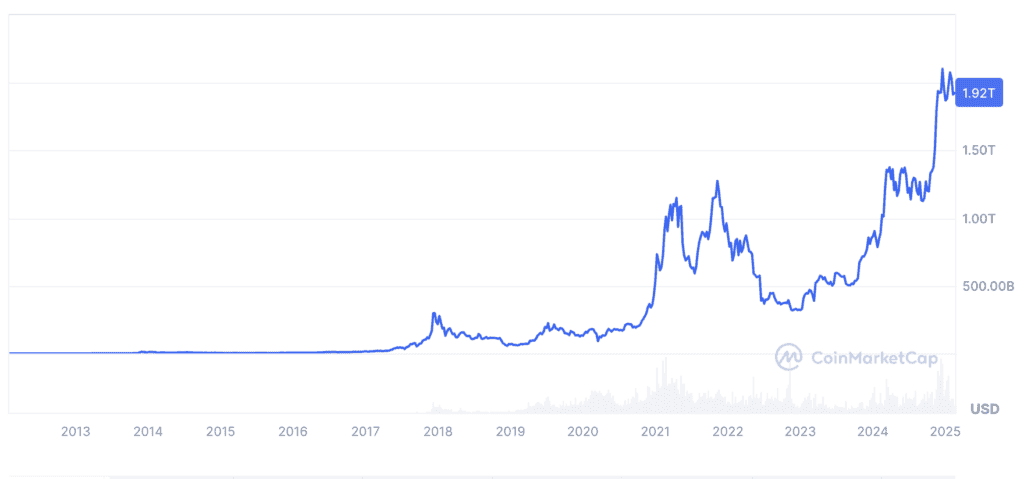
Image Source : CoinMarketCap
WHY BITCOIN OVER BEEF ?
Bitcoin can be transferred across borders in minutes and divided into smaller units (satoshis), making it more practical than gold or beef. Over the past decade, Bitcoin has delivered an average annual return of over 200%, outperforming gold, stocks, and real estate. A study by Fidelity Investments found that Bitcoin’s risk-adjusted returns are superior to traditional assets, making it an attractive option for long-term wealth preservation. Globally, nations are beginning to recognize Bitcoin’s potential as a reserve asset. El Salvador made history in 2021 by adopting Bitcoin as legal tender, while countries like Switzerland and Singapore have integrated Bitcoin into their financial systems. This is 2025 and The United States “Strategic Bitcoin Reserve” Bill is already in the pipeline. According to a 2023 report by Chainalysis, Africa is one of the fastest-growing cryptocurrency markets, with Nigeria, Kenya and South Africa leading in adoption.
Bitcoin’s deflationary nature makes it an effective hedge against inflation, which has plagued many African economies. For example, Nigeria’s inflation rate hit 34.80% in 2024, eroding the value of the Naira. A Bitcoin reserve could protect national wealth from such devaluation. By allocating just 1% of its reserves to Bitcoin, Africa could unlock billions in value. For instance, if the continent’s combined foreign reserves of 500 billion included 5 billion in Bitcoin, a 10x appreciation in Bitcoin’s value would yield $50 billion in returns. Unlike beef production, which contributes to deforestation and greenhouse gas emissions, Bitcoin mining can be powered by renewable energy. According to the Cambridge Bitcoin Electricity Consumption Index, 58.5% of global Bitcoin mining is powered by renewable energy as of 2021. Africa’s vast solar and hydroelectric potential makes it an ideal location for sustainable Bitcoin mining operations. Storing and managing Bitcoin reserves is far more cost-effective than maintaining commodity reserves. There are no storage costs, no risk of spoilage, and no need for complex logistics.
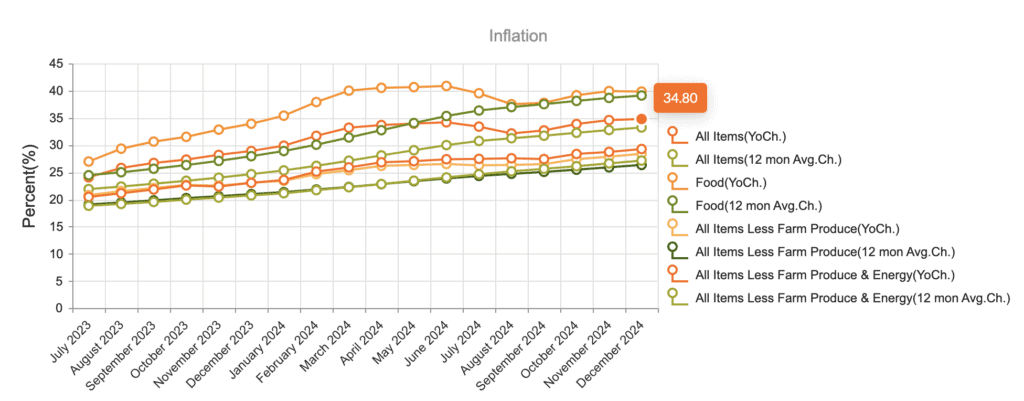
Image Source : Central Bank of Nigeria.
El Salvador’s adoption of Bitcoin as legal tender provides valuable insights for Africa. Despite initial skepticism, Bitcoin has boosted tourism and foreign investment in El Salvador. According to the Central Reserve Bank of El Salvador, tourism revenue increased by 30% in the first year following Bitcoin adoption. Over 70% of Salvadorans previously lacked access to banking services. Bitcoin has enabled millions to participate in the global economy. By reducing reliance on the U.S. dollar, El Salvador has taken a bold step toward financial independence. Many African nations rely heavily on the U.S. dollar for trade and reserves, leaving them vulnerable to external economic policies. Bitcoin offers a decentralized alternative, reducing reliance on traditional financial systems.
By establishing a Strategic Bitcoin Reserve, Africa can secure its economic future, protect its wealth from inflation, and position itself as a global leader in the digital economy. The time has come for Africa to move beyond outdated economic models and embrace the future of money. As Brian Armstrong aptly stated, Bitcoin is not just a better form of money; it is the foundation of a new financial paradigm. For Africa, the choice is clear: Bitcoin, not beef, is the path to prosperity. Bitcoin represents a transformative asset class that offers unparalleled advantages over traditional commodities like beef or mutton.
This is a guest post by Heritage Falodun. Opinions expressed are entirely their own and do not necessarily reflect those of BTC Inc or Bitcoin Magazine.
Source link

Kraken Secures Restricted Dealer Status in Canada Amid 'Turning Point' for Crypto in the Country

Binance Sidelines Pi Network Again In Vote To List Initiative, Here’s All

XRP Price Reversal Toward $3.5 In The Works With Short And Long-Term Targets Revealed

Former New York governor advised OKX over $505M federal probe: Report

First Digital USD (FDUSD) Depegs After Justin Sun Alleges Firm Is ‘Insolvent’ and Not Fulfilling Redemptions

Gen Z’s Bitcoin Bet, The Largest Wealth Transfer In History?

Trump’s Crypto Conflicts Dominate Stablecoin Legislation Debate

First Digital denies allegations, threatens legal action

Crypto Firm Galaxy Secures UK FCA Approval for License to Expand Derivatives Trading

Why Is The Bitcoin Price Surging Today?

Cardano Founder Reveals What Will Onboard 3 Billion New Users Into Crypto

Sentient open-source AI search outperforms GPT-4o and Perplexity

Memecoin Collapse Creates Perfect Moment for TradFi To Launch ‘Trusted Assets,’ According to Chris Burniske

Breez Announces Launch Of New Wallet, Misty Breez

Alabama, Minnesota Advance Bitcoin Reserve Plans With Companion Bills

Arthur Hayes, Murad’s Prediction For Meme Coins, AI & DeFi Coins For 2025

Expert Sees Bitcoin Dipping To $50K While Bullish Signs Persist

Aptos Leverages Chainlink To Enhance Scalability and Data Access

Bitcoin Could Rally to $80,000 on the Eve of US Elections

Sonic Now ‘Golden Standard’ of Layer-2s After Scaling Transactions to 16,000+ per Second, Says Andre Cronje

Crypto’s Big Trump Gamble Is Risky

Institutional Investors Go All In on Crypto as 57% Plan to Boost Allocations as Bull Run Heats Up, Sygnum Survey Reveals

Ripple-SEC Case Ends, But These 3 Rivals Could Jump 500x

Has The Bitcoin Price Already Peaked?

A16z-backed Espresso announces mainnet launch of core product

Xmas Altcoin Rally Insights by BNM Agent I

Blockchain groups challenge new broker reporting rule

The Future of Bitcoin: Scaling, Institutional Adoption, and Strategic Reserves with Rich Rines

Trump’s Coin Is About As Revolutionary As OneCoin

Is $200,000 a Realistic Bitcoin Price Target for This Cycle?
Trending

 24/7 Cryptocurrency News5 months ago
24/7 Cryptocurrency News5 months agoArthur Hayes, Murad’s Prediction For Meme Coins, AI & DeFi Coins For 2025

 Bitcoin3 months ago
Bitcoin3 months agoExpert Sees Bitcoin Dipping To $50K While Bullish Signs Persist

 24/7 Cryptocurrency News3 months ago
24/7 Cryptocurrency News3 months agoAptos Leverages Chainlink To Enhance Scalability and Data Access

 Bitcoin5 months ago
Bitcoin5 months agoBitcoin Could Rally to $80,000 on the Eve of US Elections

 Altcoins2 months ago
Altcoins2 months agoSonic Now ‘Golden Standard’ of Layer-2s After Scaling Transactions to 16,000+ per Second, Says Andre Cronje

 Opinion5 months ago
Opinion5 months agoCrypto’s Big Trump Gamble Is Risky

 Bitcoin5 months ago
Bitcoin5 months agoInstitutional Investors Go All In on Crypto as 57% Plan to Boost Allocations as Bull Run Heats Up, Sygnum Survey Reveals

 Price analysis5 months ago
Price analysis5 months agoRipple-SEC Case Ends, But These 3 Rivals Could Jump 500x


